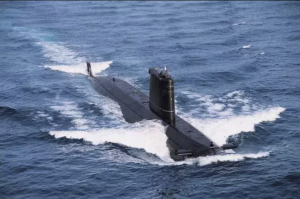In a significant development, the Indian Navy recently commissioned its second nuclear-powered ballistic missile submarine, INS Arighat, at its Eastern Command headquarters in Visakhapatnam. This new addition to India’s fleet brings with it several advanced features, surpassing its predecessor, INS Arihant, which joined the country’s blue-water force in 2016.
India’s Arighat

The Arighat, armed with K-15 ballistic missiles and an operational radius of 750 kilometres, substantially enhances the Indian Navy’s offensive capabilities. Moreover, its ability to launch long-range ballistic missiles, such as the K-4 with a range of 3,500 kilometress, places it in a league of its own. This capability brings key strategic locations of India’s adversaries, such as China’s Yunnan Province and Pakistan’s capital, Islamabad, within its strike range.
If a missile were to be launched from Indian waters in the Arabian Sea, it could target the port city of Karachi, which serves as the headquarters of the Pakistan Navy. Additionally, regions such as Punjab and Balochistan would also fall within its strike radius. Furthermore, with the Arighat’s commissioning, India now holds the ability to launch strikes on other major Pakistani cities, including Quetta, Gwadar, Lahore, Faisalabad, and Multan.
It is noteworthy that Arighat is the most modern submarine in India’s Arihant-class of SSBNs, which form the cornerstone of the country’s nuclear triad. These vessels provide India with a credible second-strike capability, thanks to their nuclear propulsion and the ability to carry ballistic missiles with nuclear warheads. With their ability to stay submerged for extended periods without needing to surface, these submarines are far more difficult to detect compared to Pakistan’s Agosta-class, which is limited to anti-surface operations with conventional missiles like the Exocet.
Pakistan’s Agosta

The Agosta-class submarines, despite relying on air-independent propulsion (AIP), must periodically surface, making them more vulnerable to detection. While Pakistan’s Agosta 90B diesel-electric submarines are technologically capable in conventional warfare, they lack the strategic depth and survivability that nuclear-powered platforms offer.
It is understood that the Arighat employs the same 83 MW reactor as INS Arihant. However, highly placed sources in the Indian Navy confirm that Arighat features far more advanced nuclear propulsion technology. This significantly reduces its acoustic signature, allowing it to operate more stealthily, enhancing both its operational effectiveness and its ability to remain undetected by enemy sonar systems.
Unlike India, Pakistan does not possess nuclear submarine capability. With the commissioning of both Arihant and Arighat, India has pulled ahead in terms of having a credible second-strike nuclear deterrence from the sea. “Pakistan lacks any nuclear-capable submarines. While some reports suggest they may seek assistance from China, as of now, it is evident that Pakistan does not have the capability to field nuclear submarines,” stated a retired Indian Navy officer, speaking on condition of anonymity.
He further emphasised that India’s nuclear submarine programme is set to witness significant advancements, with next-generation ballistic missiles expected to be installed on these submarines. These future missiles are projected to have a range exceeding 1,500 km, more than doubling the current range of 750 km of the K-15 missiles.
Future prospects
The Indian Navy veteran also noted that Pakistan poses no immediate challenge in this domain, as they currently operate only conventional submarines. However, he acknowledged that Pakistan has made some strides in air-independent propulsion (AIP) technology, which allows their submarines to remain submerged for longer periods compared to traditional diesel-electric submarines. Nevertheless, India’s acquisition of Seahawk helicopters and P-8I Poseidon maritime patrol aircraft—both known for their potent anti-submarine warfare capabilities—effectively neutralises the threat posed by Pakistan’s underwater fleet in the North Arabian Sea.
The Indian Navy’s nuclear submarine fleet not only strengthens its deterrence capabilities but also reaffirms India’s strategic superiority in the region. With advanced platforms like Arighat, the Indian Navy is well-positioned to safeguard the nation’s maritime interests and maintain an edge over regional adversaries.
Author

Ruchi Singh is a seasoned journalist specialising in defence, security, foreign affairs, and aerospace. With a distinguished career at leading news channels such as TV Today Network, India News, News24, and Zee News, she has become a trusted voice in the industry. As a producer and analyst, Ruchi delivers incisive and impactful stories that resonate with both audiences and policymakers. Follow her insights on Twitter: @RuchiSinghNews.















